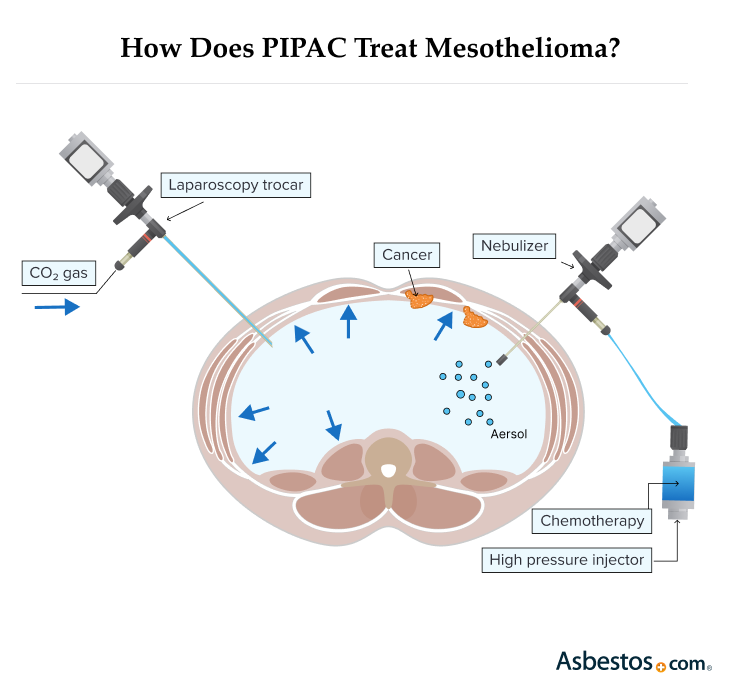PIPAC for Mesothelioma
Pressurized intraperitoneal aerosolized chemotherapy is a way to deliver chemotherapy to the abdominal lining. PIPAC is different from traditional chemo because it uses pressure and turns the medicine into a mist. This may help the medicine better reach cancer cells.

What Is PIPAC?
PIPAC is a mesothelioma treatment that delivers chemo directly to the abdomen using a pressurized aerosol. This means the chemo drug is turned into a fine mist.
Key Facts About PIPAC
- PIPAC delivers chemo to the abdominal lining.
- Chemo is turned into a mist.
- PIPAC uses pressure to help the medicine spread.
- PIPAC may extend survival for peritoneal mesothelioma patients.
PIPAC, which stands for pressurized intraperitoneal aerosolized chemotherapy, is a newer treatment for mesothelioma. Researchers are currently studying the new treatment to see how well it works. Doctors are hopeful PIPAC can help people with peritoneal mesothelioma. This type of mesothelioma affects the lining of the abdomen.
How Does PIPAC Treat Mesothelioma?
PIPAC for mesothelioma uses a special delivery method to treat the cancer. First, the chemo is placed directly into the abdomen. Second, a pressurized aerosol mist helps the mesothelioma chemotherapy reach more of the cancer cells.
The PIPAC procedure delivers the chemo mist throughout the abdominal cavity. This intraperitoneal chemotherapy allows the medicine to reach more of the affected areas. It may be more effective than traditional chemo for peritoneal mesothelioma.

What to Expect With PIPAC for Mesothelioma
Preparing for PIPAC is like preparing for mesothelioma surgery. You’ll undergo tests and talk to your doctors, who will tell you how to prepare. During the procedure, you’ll be asleep under anesthesia. The doctors will make small incisions in your abdomen to insert the tools needed for PIPAC.
Steps of a PIPAC Procedure
- Small incisions: The surgeon makes small cuts in the abdomen.
- Inserting tools: Special tools are inserted into the abdomen.
- Chemotherapy delivery: The chemotherapy is turned into a mist and sprayed into the abdomen.
- Absorption time: The mist is left for a certain amount of time to maximize penetration.
- Closing incisions: The tools are removed, and the incisions are closed.
The delivery of chemo takes about 30 minutes. With prep, the procedure itself and post-procedure monitoring, the whole process takes about 60 to 90 minutes.
You’ll likely stay in the hospital for a few days after PIPAC. Recovery will depend on your overall health and how your body responds to the mesothelioma treatment. Your doctor will give you specific instructions for recovery.

Get a free guide with the latest mesothelioma treatments and clinical trials.
Get Yours NowBenefits of PIPAC Surgery for Mesothelioma
PIPAC surgery offers several potential benefits for people with peritoneal mesothelioma. It’s a targeted approach that delivers chemo directly to the abdominal lining. This can potentially reduce side effects compared to traditional chemo.
Chemo is usually given through the bloodstream via an IV, which can cause whole-body or systemic side effects. Applying chemo directly allows higher doses to reach cancer cells and limits side effects in the rest of the body.
PIPAC’s Benefits for People With Mesothelioma
- May reach more cancer cells than traditional chemo.
- Potentially fewer side effects than traditional chemo.
- May improve quality of life for some patients.
- A study in BMC Cancer reported significant remission of peritoneal mesothelioma tumors in more than 51.7% of patients. About 10% of peritoneal patients went into complete remission.
These benefits may significantly improve the lives of people with mesothelioma. The success of PIPAC for mesothelioma patients is promising, offering hope for improved outcomes.
Side Effects of PIPAC
Side effects of PIPAC may include pain and fatigue. While PIPAC is designed to target mesothelioma cells, it can still affect healthy tissues.
Pressurized Intraperitoneal Aerosolized Chemo Side Effects
- Abdominal pain or discomfort
- Changes in bowel habits
- Fatigue
- Infection
- Nausea and vomiting
Rare but serious side effects, such as infection, can also occur. It’s important to discuss all potential side effects with your doctor. Early detection of side effects ensures your doctor can take steps to minimize or treat them.
How to Manage Side Effects?
Your doctor will work with you to create a plan to manage any PIPEC side effects that arise. Managing side effects is an important part of PIPAC treatment.
Tips for Managing PIPAC Side Effects
- Follow your doctor’s instructions carefully.
- Take medications as prescribed.
- Stay hydrated.
- Get plenty of rest.
- Eat a healthy diet.
- Request anti-nausea medication if necessary.
Patients should report any side effects to their doctor promptly. Early intervention can help manage side effects more effectively.
Are You Eligible for the PIPAC Procedure?
Mesothelioma patients who are eligible for PIPAC are in relatively good overall health. PIPAC is a major procedure, and your peritoneal mesothelioma doctor will determine if you’re a good candidate.
PIPAC is still under investigation in clinical trials in the U.S. Each trial has its own rules about who can participate. These rules are called eligibility requirements. In general, you must be physically able to undergo the procedure and tolerate the chemo.
How to Receive PIPAC Treatment for Mesothelioma?
PIPAC is available through mesothelioma clinical trials. Your cancer center or a Patient Advocate can tell you about available trials in your area or nearby states. Your doctor can refer you to a mesothelioma specialist who can evaluate you for a clinical trial.
This procedure isn’t widely available at peritoneal mesothelioma treatment centers yet. These trials test how well PIPAC works and who it helps the most.

Connect with trusted specialists who truly care about your health. Get fast, stress-free appointment help.
Find a Doctor NowPIPAC vs. HIPEC: What’s the Difference?
PIPAC and HIPEC deliver chemo to the abdomen in slightly different ways. HIPEC uses a liquid, while PIPAC uses an aerosol mist.
Both PIPAC and HIPEC have potential benefits and drawbacks. HIPEC for mesothelioma is a more established treatment. PIPAC is newer and is still under investigation.
| Key Differences | PIPAC | HIPEC |
|---|---|---|
| Temperature | Room Temperature | Heated |
| Delivery Method | Aerosol (mist) | Liquid |
| Timing | Can be repeated multiple times | Typically done once during surgery |
| Number of Treatments | Multiple treatments may be possible | Sometimes doctors repeat the procedure |
Common Questions About PIPAC
- How much does PIPAC cost?
-
The cost of PIPAC varies. Cost depends on many factors, including where you receive treatment and your insurance coverage. Certain clinical trials may cover this new treatment. Talk to your doctor and insurance provider for more information.
- Is PIPAC a cure for mesothelioma?
-
No, PIPAC isn’t a cure for mesothelioma. It’s a treatment that may help control this cancer and improve symptoms.
- How many PIPAC sessions are needed?
-
The number of PIPAC sessions needed varies. Your doctor will determine the best treatment plan for you.
- Does insurance cover PIPAC?
-
Insurance coverage for PIPAC isn’t guaranteed. Check with your insurance provider to see if it’s covered. A clinical trial may cover the cost of PIPAC.
- Can PIPAC be combined with other treatments?
-
Yes, PIPAC may be combined with other treatments, such as surgery or traditional chemotherapy. It may also be combined with NIPEC for mesothelioma, which is another type of intraperitoneal chemo. Your doctor will decide what is best for your situation.



